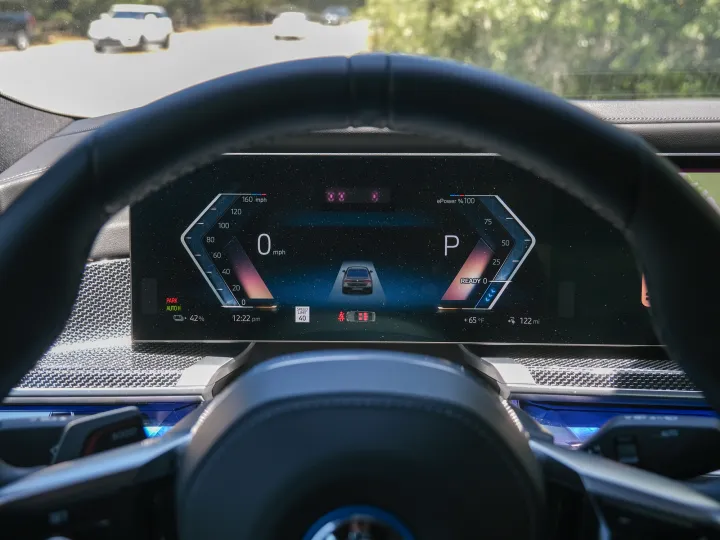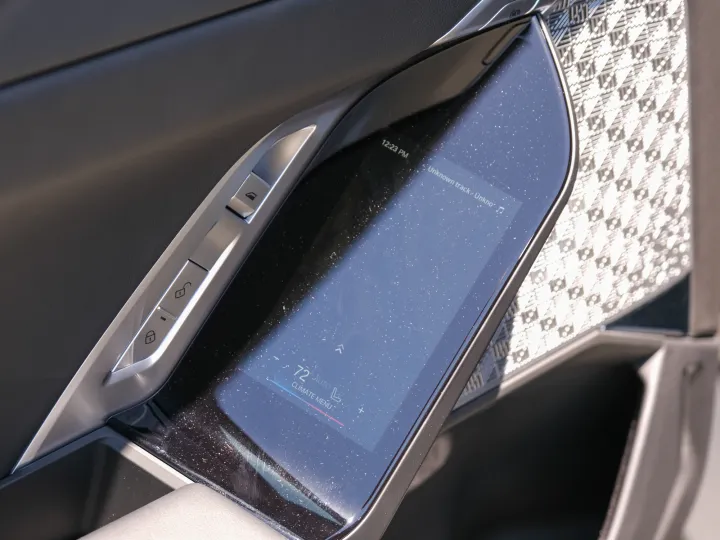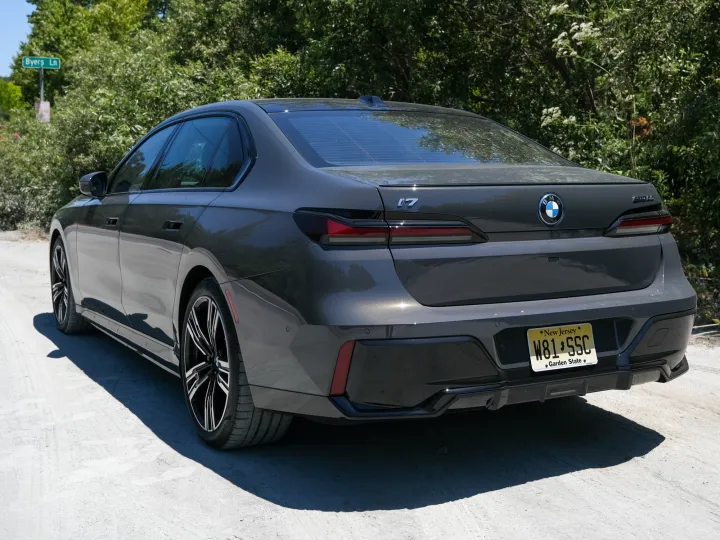2024 BMW i7 eDrive50 review: ultimate luxury
MSRP $105,700.00
“The BMW i7 is built for comfort and luxury — not necessarily top performance.”
Pros
- Incredibly comfortable interior
- Excellent tech features
- Stunning design on the inside
- Relatively agile drive
Cons
- Controversial exterior
- Not the most performance-focused
The luxury electric car world has heated up a whole lot over the past few years. Between models from legacy carmakers like Mercedes-Benz and newcomers like Lucid, there’s plenty of choose from. BMW’s take on a luxury electric sedan is the BMW i7, a car that comes with a huge TV for the passengers, depending on the trim you get.
The BMW i7 is built for a comfortable, tech-heavy drive, allowing the driver and passengers alike to tailor their i7 experience to their needs. But it also costs a hefty $105,700 — and that’s for the BMW i7 eDrive50, which is the base model of the car. That is the model of i7 I’ve been driving for the last week — a car that sits under the mid-tier xDrive60 and the top-level M70.
While it’s not as expensive as the top-tier trim, it’s still not cheap by any means — and it faces stiff competition. Does it beat out the likes of the Lucid Air and Mercedes-Benz EQS?
Design and interior
The design of the BMW i7 is a little controversial. It’s perhaps not as unique as that of the i3 or the i8, but it still looks unlike most other BMW models. The car is pretty huge, with slim headlights at the front and a huge kidney grille — something that’s sure to be divisive. The car is famously available in two-tone color-schemes — but we’re reviewing a model in the Dravit Gray Metallic color, which is a little more subtle.
I’m a little torn on the overall design of the car. It’s not the best-looking vehicle out there, but I also don’t hate it. I do find aspects of it to be a little over the top, but again, it’s not as crazy as some of BMW’s other recent vehicles. That said, our review car did come with the M Sport Package, which meant it had larger 21-inch wheel.
The interior of the vehicle is built for luxury, and that’s immediately clear when you get inside the vehicle. It’s very luxurious, with plush padding on the seats, which also house heating and cooling. The seats are covered in a soft leather, and there’s really nothing about the interior that looks or feels cheap — unlike some of the competition in this price range.
One of the things I really like about the i7’s interior is the fact that it puts a heavy emphasis on passenger-row comfort. There’s a small display in the arm of the two back doors, which allows users to set window shade levels and third-zone temperature. The rear seats also have heating, cooling, and massaging, which is nice to see. The car is available with a massive 31.3-inch display — but our model didn’t come with that option.
Generally, the i7 is perhaps the most comfortable car out there, at least as it pertains to comfort for everyone in the car, and not just those in the front seat.
Tech, infotainment, and driver assist

The car is very tech-heavy too. We already went over the displays in the rear seats, which are genuinely helpful — though slightly slow at times. There are other screens around the car, too, though. Notably, the i7 offers a large curved display at the front of the car, which is made up of a 12.3-inch instrument display and a 14.9-inch infotainment display.
They’re both excellent-looking screens, with bright colors and crisp detail. The car comes with BMW’s iDrive 8.5, which isn’t bad. It’s still not the fastest infotainment system out there, and can be a little confusing to navigate. I also found it freeze up a little more than I would have liked. However, I do like the widget layout — and you can even have CarPlay or Android Auto exist as a widget, if you want to show other information from the car. I generally kept CarPlay at full-screen though.

The BMW i7 offers some helpful driver-assist features, though don’t expect features on the same level as some more tech-focused cars out there. The car does have an adaptive cruise control feature and a lane assistant — so it can feel almost like it’s self-driving on the highway. It also has things like a 3D view of the traffic around you on the instrument display, for example. And, as an option, our car came with a parking assistant, which is a feature I usually have to remember to use on test cars, as it’s still not my first instinct. Presumably, if I owned one of these test cars, I’d get into the routine of using it. Regardless, the car has a helpful set of features overall.
Driving experience
Actually driving the BMW i7 is an excellent experience. The base model of the vehicle has a single motor that powers the rear wheels, while the xDrive60 and M70 have two motors that power an all-wheel drive system. Our car was able to hit 60 miles per hour in 5.3 seconds.

Sure, that’s not as quick as many of the other electric vehicles out there — even some much cheaper ones. But it’s still decently fast and makes it easy to quickly overtake other cars on the highway, for example. Remember, this vehicle is built for comfort and luxury — not necessarily top performance. That said, of course, if you spend enough for the M70, you’ll get both (the M70 has an acceleration from 0 to 60 miles per hour of 3.5 seconds).
The i7 is big and heavy, but I found the steering to be relatively responsive and the car in general to be a little more agile than I expected. The car’s cabin is very quiet, even at faster speeds, and the suspension helps make it feel very smooth. That’s what you would want for a car like this — you won’t feel every little bump in the road, which you would want on a more performance-focused vehicle, but that’s a good thing here.
Range and charging
The BMW i7 has offers between 274 and 321 miles of range, depending on the trim and options you go for. The eDrive50 has the highest range, presumably because the battery only has to power one motor, and the range varies from 301 to 321 miles depending on things like the wheel type and other options.

It’s a good range, and we’re glad that the base model of the car hits 300 miles. And in my experience, the estimates seemed about right. However, there’s another luxury electric vehicle that kind of blows the i7 out of the water — the Lucid Air. Even the base model of the Lucid Air, which is $69,900, has 419 miles of range. If range is your top concern, then the Lucid Air is the luxury electric sedan to buy.
The BMW i7 charges at up to 250 kilowatts, which BMW says will give the car 100 miles of range in 12 minutes. It’s a fast-enough charging speed — but not as fast as the fastest-charging cars out there, like the Kia EV6 and Hyundai Ioniq 5.
How DT would configure this car
The BMW i7 has a lot going for it — even if you go for the base model. The car does what it sets out to do by offering a great EV experience with an incredibly luxurious interior. Really, the i7 might well set the bar for a comfortable ride, so if that’s a priority to you, then it’s easily worth considering this car.
The i7 isn’t necessarily built for performance, but if you do want to get one, we recommend upgrading to the all-wheel-drive i7 xDrive60. You probably don’t need the much more expensive M70, but having at least two motors really will make for a more nimble drive.
That said, of course, it’s also worth considering other vehicles. If you want a luxury car that prioritizes “electric car things,” like range, charging, and that superfast acceleration, then the Lucid Air is still a much better option, and for a lower price. If you’re willing to spend i7-type money on an Air, you can upgrade to the Lucid Air Grand Touring, which has options for a 500plus mile range, and an incredible acceleration time of 0 to 60 miles per hour in 3 seconds.
Editors’ Recommendations





